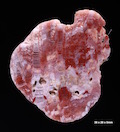
 |
| Clyde Coast Agatised Coral |
Occasionally when looking for agates on the beaches of South Ayrshire, South Arran, the Mull of Kintyre, parts of Northern Ireland and even the northern shores of the Isle of Man it is possible to find pieces of coloured Agatised coral. The source of this material is uncertain and as no specimens have been found in situ in any rock exposures on the land the source presumably must be somewhere on the seabed in the lower reaches of the Firth of Clyde. Alternatively the pieces may have been distributed by glacial action from an ancient source. Although the quality of the found pieces varies from incompletely to completely silicified the best examples have been beautifully preserved in red, clear, grey and white agate. These comprise several species of common rugose corals of the Lower Carboniferous Period (Upper Visean to Lower Namurian including Lithostrotion and Lonsdaleia). Lower Carboniferous rocks outcrop at several places around the Clyde coast but both the origin and formation process of this beautiful material is unknown. However it could be contemporaneous with the agates to be found at nearby Dunure. |
 |
 |
Photomicrograph of silicified coral, Maidens Beach in polarised light. x4 |
Photomicrograph of silicified coral, Maidens Beach in polarised light. x10 |
This material is quite rare and not many examples have been found over the last 10-20 years. A Dutch collector, Trijntje Blaauwwiekel, has been particularly successful finding this agatised coral mainly due to her patience and persistence. All the specimens have been found on the beaches of mainly Ayrshire, Kintyre and the southern part of the Isle of Arran. They usually found within the shingle beach and comprise loose blocks that are well rounded and water worn. This is rare material and is found as the result of extensive searching. The specimens are small, between 50 to 100mm, although larger specimens up to 200mm have rarely been found. |
 |
 |
 |
 |
 |
 |
 |
 |
 |
 |
 |
| < Ayrshire |
| .....and a few more recent finds: |
 |
 |
 |
 |
 |
 |
 |
 |
 |
 |
| < Ayrshire |